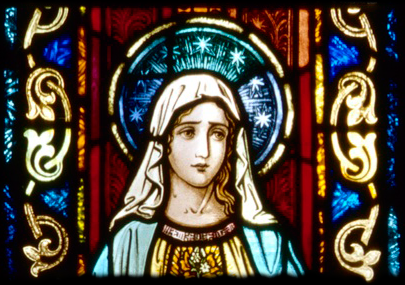of
BLESSED VIRGIN MARY
Chapel
then do what's possible; and
suddenly you are doing the impossible.
- St. Francis of Assisi

PRE-DESIGN SURVEY REPORT
CHEMICAL ANALYSIS of CONCRETE– REPORT EXCERPT
BUILDING SURVEY – REPORT EXCERPT
RECOMMENDATIONS - Phase IV - Future Work
November 2016 - Simpson, Gumpertz, & Heger (SGH), a world-class structural and material engineering firm with expertise in restoration and preservation of historic masonry and slate roofs, was consulted for the following:
- Chemical analysis to determine causative factors in the deterioration of the pre-cast exterior decorative concrete
Core drilling decorative concrete for chemical analysis. (Loven Contracting, Inc.)
- Inspection of building envelope - slate roof, gutters, rear chimney, window and door openings

The investigative engineering report (finalized May 2017), detailed results of chemical analysis of the pre-cast decorative concrete, and outlined restoration options as follows:
- Alkali Silica Reaction (ASR), further described below, is the primary factor in the extensive and on-going decay of the decorative concrete
- Preservation – the decorative concrete would require substantial periodic repair & maintenance (every 7 to years)
- Replacement – complete removal and replacement of decorative concrete may be the most effective long-term restoration approach
CONCLUSION SUMMARY - SGH REPORT EXCERPT:

- Preservation: Repairs to retain blocks where feasible include – remove the existing coatings, repair cracks and spalls, repoint joints, and paint the blocks with a breathable elastomeric coating. This approach will only slow down the deterioration from ASR. Periodic repairs, including patching new cracks and spalls and recoating will be required every 7 to 10 years. While the up-front cost is lower than the replacement option, significant periodic maintenance will be required.
- Replacement: The only other viable corrective action for ASR is wholesale replacement of the affected architectural veneer and features. The advantage of replacement is that it will indefinitely solve the problem. However, upfront costs will be much higher.

BUILDING SURVEY – REPORT EXCERPT
The report summarized the building envelope as follows:
Steep-slope roofs: The slate roofs are generally in good condition but deferred maintenance will need to be addressed, if not immediately, in the near future to prevent leakage and damage to the interior.
Low-slope roofs: The low-slope roofs are in fair condition but suffer from faulty and deferred maintenance. Deferred maintenance will need to be addressed, if not immediately, in the near future, to prevent leakage and damage to the interior. When low-slope roofing is replaced, it should be designed with improved details for better durability and water tightness.

Volcanic rock and cement plaster walls: These walls are generally in good condition and need routine maintenance. However, at the top of the chimney there is some loose masonry and mortar that should be repaired, as it is a falling hazard.
Windows and doors: Windows and doors require new perimeter sealant, new glazing sealant at the protective glazing, and minor repairs. The stained-glass windows show some signs of distress and should be evaluated by a stained-glass conservator.
Conclusion: Our report contains these recommendations and prioritizes work based on risk to the integrity of the building envelope and the estimated remaining life cycle of the material or system.
RECOMENDATIONS: Phase IV - FUTURE WORK & FUNDING

- LIDAR laser scan of exterior elevations
- analysis of most cost effective and sustainable restoration methods and materials
- construction blueprints
- prioritized schedule of work - restoration phases and related budget
READ MORE: SGH – CONDITIONS REPORT – May 2017 (PDF - 20MB)
READ MORE: FUTURE WORK & FUNDING

~ Ave Maria ~
